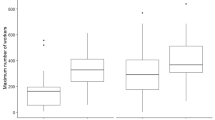Summary:
In this study we describe colony development, larval development, worker reproduction and mating frequency of the queen in laboratory colonies of Bombus impatiens Cresson. Comparison of our observations with data from B. terrestris - the best studied bumblebee - revealed both similarities and dissimilarities between the two. Colonies of B. impatiens have a high number of workers (374.5 ± 108), but relatively low number of young queens (9.4 ± 20) and males (8.9 ± 20). As in B. terrestris, size differences between the castes in B. impatiens were pronounced and became conspicuous as differences in the molting weight of the larvae, starting at the second instar. Workers are able to lay eggs and about 9% of the workers in old colonies had mature oocytes in their ovaries. Despite this, workers were almost never observed to lay eggs in the presence of the queen, and the "competition phase" which is known from B. terrestris was never observed. Mating frequency of the queen was examined using molecular techniques. Two out of ten queens had mated with 2 different males, suggesting some degree of polyandry in the population.
Similar content being viewed by others
Author information
Authors and Affiliations
Additional information
Received 18 June 2001; revised 17 December 2001; accepted 19 February 2002.
Rights and permissions
About this article
Cite this article
Cnaani, J., Schmid-Hempel, R. & Schmidt, J. Colony development, larval development and worker reproduction in Bombus impatiens Cresson. Insectes soc. 49, 164–170 (2002). https://doi.org/10.1007/s00040-002-8297-8
Issue Date:
DOI: https://doi.org/10.1007/s00040-002-8297-8




